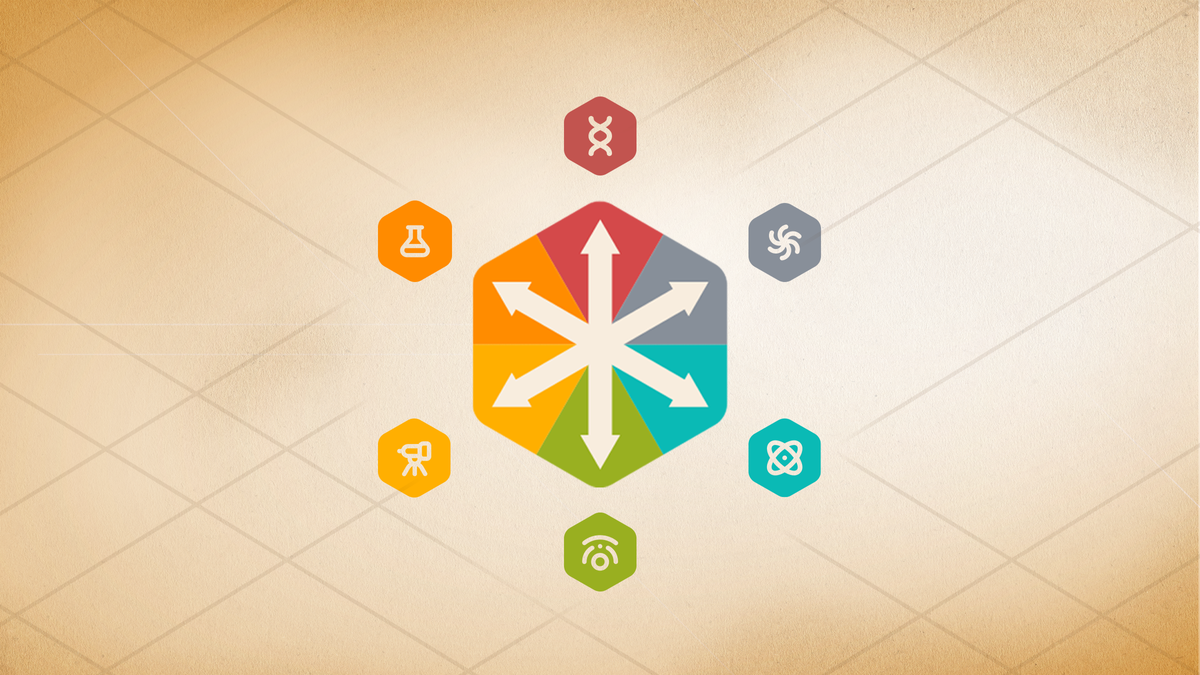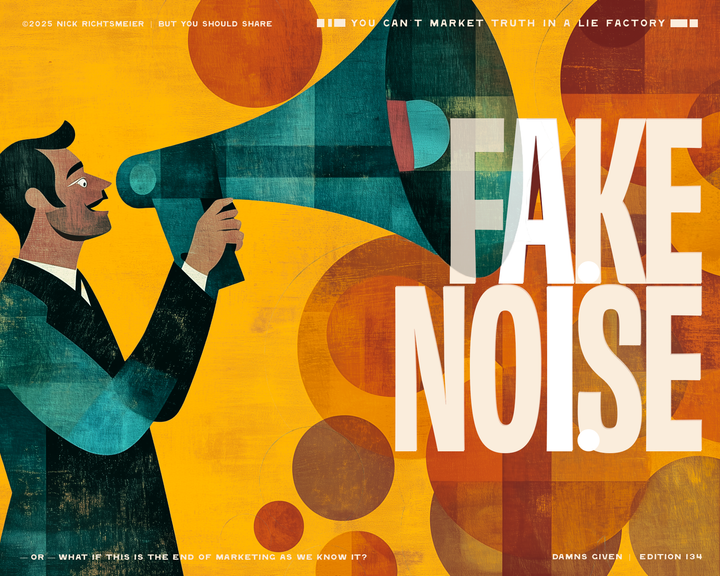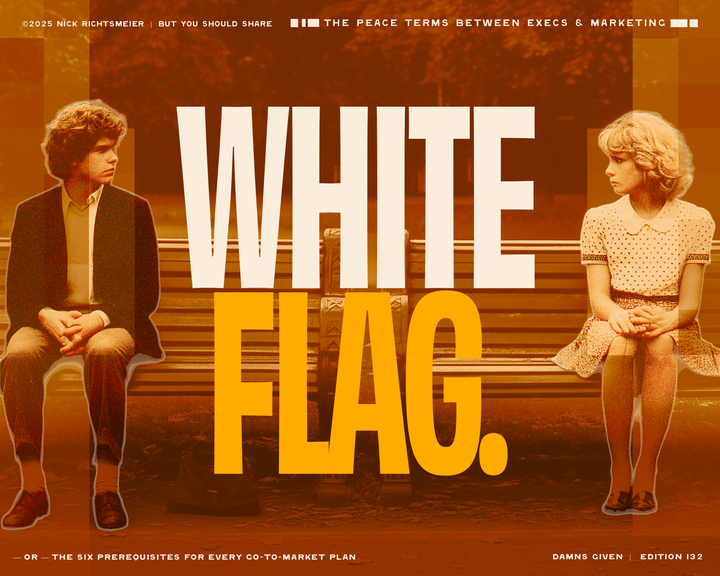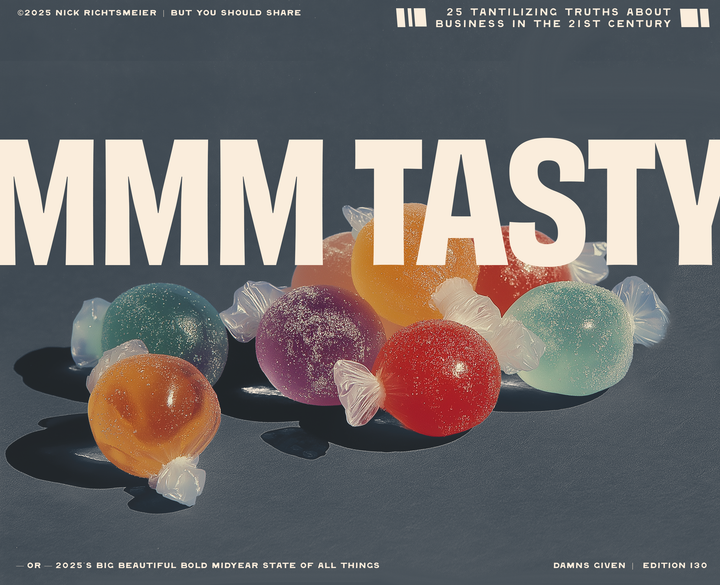It's not you. It's the *gestures broadly* this 👉
This polarization and degradation of trust at scale is incontrovertible and organizations that ignore its effects on how buyers buy and clients trust do so at their peril. Leaders say, "We don't know what happened. We used to have no problem getting new clients, now... if we're honest..."

FWD 120: Trust Decay and Three Defining Statements
Central to everything I've researched, written, and advised our family of clients on in the past three years is a singular premise:
The landscape for growing ventures has dramatically changed post-Covid. The Covid era, we will look back, was a generation-shaping event that will take decades of cultural, political, and commercial teeth-grinding to work out. 2019-2022 is the Vietnam conflict, the implosion of the counterculture, and Civil Rights movement all rolled into one, uniquely designed for the 21st century and injected into the bloodstream of every person through a hardline IV called the internet.
This polarization and degradation of trust at scale is incontrovertible and organizations that ignore its effects on how buyers buy and clients trust do so at their peril. Every week we talk to leaders of firms who say, "We don't know what happened. We used to have no problem getting new clients, now... if we're honest..." and they finally tell themselves and us the truth about how hard it's gotten out there.
I'm laser-focused through this publication this year to deliver to you two key things:
1) How to diagnose the effects of Trust Decay in your organization and to give you eyes to see why it is the central feature in your challenges with organic growth. It's not about the marketing.
2) How to isolate and address your unique and specific factors of Trust Decay combined with your unique and specific superpowers for overcoming these climatic headwinds.
Today's post is simple: A diagnostic for how much Trust Decay is impacting you. The higher you score on this diagnostic the more at risk you are. Don't worry too much if you score high, the organizations we work with are particularly at risk to these systemic changes and we are built to solve for it if you need the help.
The Simple Trust Decay Diagnostic
I just need you to score your venture (your firm, your school, your community org, your startup) from 1-10 on three statements. A low score means you don't identify with the statement. A high score means that the statement describes you well.
Here we go. Remember 1 = not true of us at all, 10 = totally true of us
- Whole is More than the Sum: We provide a product or service where the whole is more than the sum of its parts and the value to the client/customer/constituent is hard to quantify, often because we deliver transformative outcomes.
- Here for the Long Haul: For people to experience the best of what we have to offer, we engage them in long-term relationships, sometimes lasting years or decades.
- This'll Cost You: Because of the transformative value and the often bespoke nature of our work, we are not cheap and if accounted for in total dollars paid, our clients would consider what they pay us a meaningful investment.
Score each from 1-10. Now add all three together. Here's the deal:
3-12: You are making a commodity sale that likely is best-served by playing the digital marketing game. Hire the best digital marketing team you can and get to work.
13–20: You are exposed to Trust Decay in meaningful ways and almost assuredly need to address one or more of the Trust-Made Growth Factors listed below.
21-30: Trust Decay has transformed your industry and your business, even if no one's talking about it. The fundamental way you attract, cultivate, and replicate your best clients and constituents likely has to change, maybe even dramatically if you want to compete and lead.
Solving for Trust Decay
We solve for this systemic reality through a programmatic framework (Trust-Made Growth™️) that is proven across industries, but that produces bespoke solutions for each firm and leader. Because we're solving for trust, the solutions have to be custom. Trust is always personal.
As a primer, here are the six factors of Trust-Made Growth, stay on till the end and you can link to our free assessment of how these are showing up in your organization:

CULTURE
Culture is the implicit way of being in an organization made up of its myths, rhythms, artifacts, and stories. It is made and unmade by relationships.
All organizations have a Culture, and most think they have a great culture. People like to work there. They give positive reviews on surveys. They have limited complaints. They've spent a lot of money developing their mission and values.
Growth Culture, by contrast, is a way of organizing people, time, structure, and purpose within an organization that deepens trust between all parties and makes everyone want to grow. It leverages people's natural capacity for growth in a way that is generative, healthy, and repeatable.

COMMUNITY
Community is how we imagine, engage, and activate our best prospective and current clients, constituents, team members, and partners.
Relationships are the playing field of trust. A network of relationships is a community. In our highly digitized age where nearly everything we think about, read, or consider is mediated through some form of technology, we are less able to build networks of real relationships than ever.
It's no wonder growth is suffering in ventures from colleges to advisory firms. A venture's health and capacity for growth is directly proportional to its understanding and engagement with an intentional community of prospects, clients, and partners.

ORG DESIGN
Org Design is how we allocate authority, responsibility, and accountability. It is the system of agreements between roles and departments that define the venture's outcomes.
You've heard it said that all organizations fall to the level of their systems, and this is true. Or at least partially so. Systems are just one piece of the network of decisions that make up organizational design.
Fundamentally, Org Design is about how we collaborate, how we distribute power and authority, and what we hold accountable for what. A venture's Culture contributes mightily to your growth capacity, but not without the companion of Org Design.
You can have the best people and the most valuable products and services and still suffer from an inability to grow because your business is not designed for growth.

POSITIONING
Positioning is how we understand the choices our clients make and how we define our ability to solve their problems vis-a-vis all the other options they could choose.
You'll make very little long-term progress as a venture if you don't understand the choices your priority prospects are making. Some of that is about understanding your competitive set, but more broadly it is about knowing deeply what its like for your best future clients to choose you (and not choose you).
Once you understand that, including the category of choices in which you live, then it's your job to position your venture (and its services) for your customer. This goes beyond the pedantic list of "differentiators" and goes to building all factors of an organization to produce a truly unique offering for the people you would most like to serve.

VALUE CREATION
Value Creation is the confluence of service design and engagement powered by a deep understanding of your ideal client.
Trust grows when you consistently deliver value. Trust becomes an engine for growth when you deliver value at the pace, in the form, and with the care that your customer expects. That also requires you to manage and craft those expectations.
Value creation is about building the ladder of client engagement (as a contrast to the false promise of the "sales funnel") Your best customers aspire to maximize what you offer, they want to be the kind of people that work with you. Delivering packaged value strategically is how you manage and expand that aspiration.

POINT OF VIEW
Point of View is the engine behind differentiation powered by clear beliefs and distinguished thinking about everything your venture touches.
Point-of-View is how you evangelize your value. It means you have something to say about what your customer should know. what they should expect, and of course, what they should do.
Transactional growth occurs when you consistently sell a solution. Consistent and self-generating growth occurs when you are seen as the firm that best understands the problem.
In many cases, ventures with the most actionable point-of-view see the industry in which they are positioned as part of the problem and are leading customers away from the mediocrity of a defined status quo.



